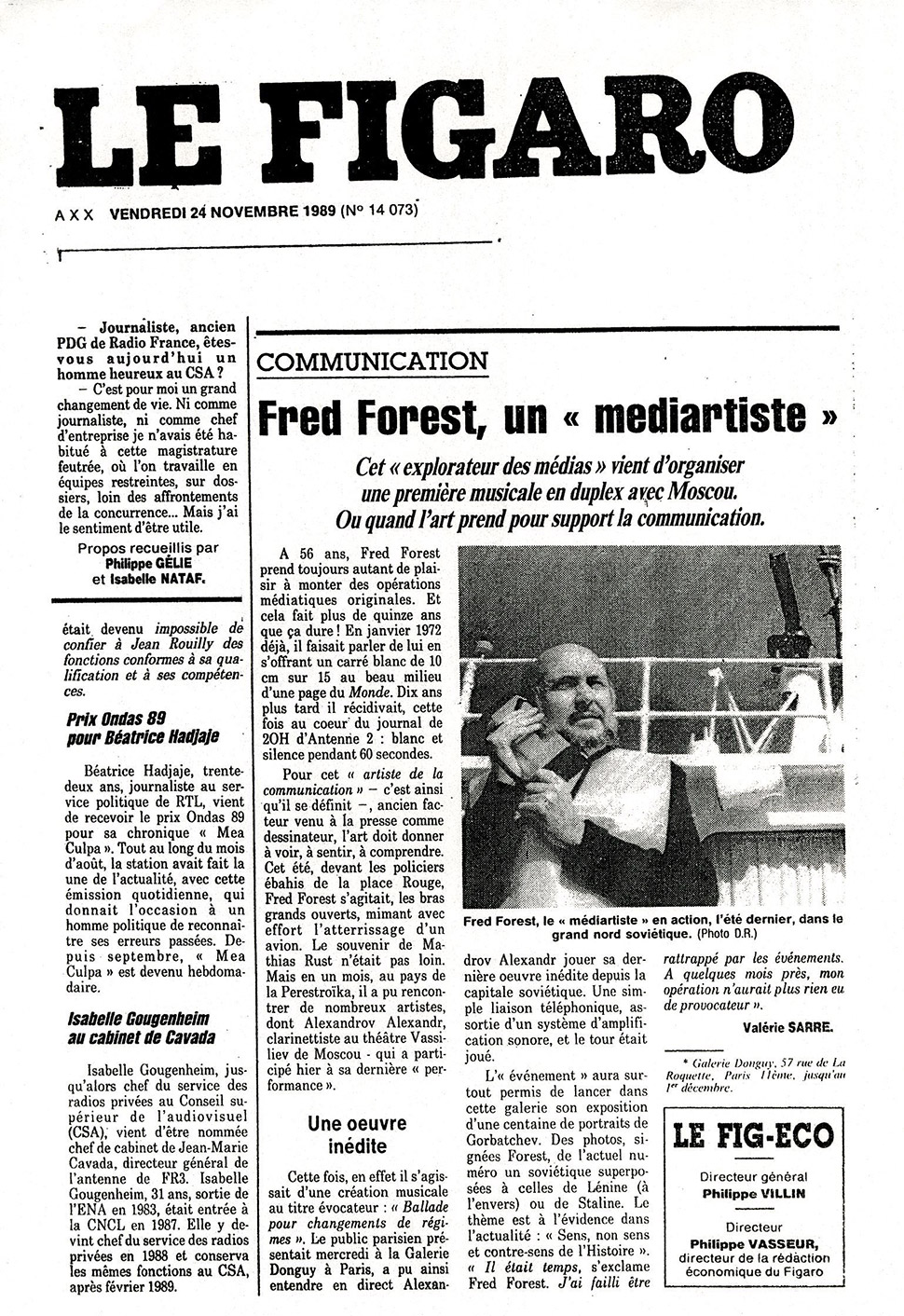Ballade pour un changement de régime en douceur
GALERIE DONGUY, PARIS - 20 NOVEMBER/ 2 DECEMBER 1989
Musical creation Moscow-Paris by telephone with Alexandrov Alexandre, bass clarinet.
GALERIE DONGUY, PARIS - 20 NOVEMBRE/ 2 DÉCEMBRE 1989
Création musicale Moscou-Paris par téléphone avec Alexandrov Alexandre, clarinette basse.
Concept
By commissioning a musical work from a Soviet artist, the title of which he had defined in advance: "Ballade pour changement de régime", Forest's intentions were not without provocation.
This project, completed in Moscow in August 1989, while the Berlin Wall was still in place, was a prophetic precursor to current events. Not only is it a kind of heartfelt tribute to Michael Gorbachev, it also critically and ironically highlights the mystifications and tragic errors of history.
Forest always creates devices in which the structure of communication is, in itself, a producer of meaning, and this is a specific feature of his artistic practice. In the "work" presented on this occasion, both the "content" and the "context" are not negligible. What's more, it offers a visual environment that lasts longer than the actual performance. Built up in successive layers for our understanding, the structure of the action refers to several levels of perception: political, communicational, philosophical, aesthetic, technological...
In keeping with his own theories on the Aesthetics of Communication, Fred Forest uses a technical device to create an "other place" and a remote "co-presence" in the telephone exchange. But in the historical-political-geographical context of the moment, his performance for the very large audience present (400 people on site, plus all the radio listeners...), paradoxically turns out to be more 'magical' than mediatic.
It is in this paradox and this hiatus that his art lies. It shows that in the exchange we never tire (and in the context, it's a kind of 'miracle' of history...) of experimenting with that minimal function of communication that Roman Jakobson calls phatic. A function that consists, here, on Forest's invitation after 70 years of interruption, of verifying, with a sort of naive wonder, that communication is working again. That communication is working again, and that everyone can see and experience it...
At different heights, hanging on the walls of the Gallery, electronic newspapers, in a dizzying array of numbers, parade dates before our eyes in an uninterrupted movement. These are the dates that have marked the history of the Soviet Union since 1917. This parade of numbers, without reference, at speeds that accelerate like the movement of history, inspires in us a profound sense of absurdity.
Device
- Amplified telephone link between the Galerie Donguy and the Vassiliev Theatre in Moscow
- Live radio broadcast on France-Inter, on 20 November from 6.30pm to 6.45pm on Philippe Aubert's "Aubertinage" programme
- 50 portraits of Lenin, 50 portraits of Gorbachev, 1 portrait of Khrushchev, 1 portrait awaiting execution in an empty frame, 1 certificate of good and loyal service signed by Lenin
- 5 illuminated diode newspapers
- " Le médiartiste ", Le Point n°85, Paris, novembre 1989
- " Fred Forest médiartiste ", Le Figaro n°14073, Paris, 24 novembre 1989
- " Ballade pour changement de régime ", Annick Bureaud, Kanal Magasine Paris, n°5, février 1990
- "Le sens de l'histoire", Arte Factum, Isabelle Rieusset-Lemarié, Anvers, avril/mai 1990

LONG BIOGRAPHY OF FRED FOREST
Fred Forest has a special place in contemporary art. Both by his personality and by his pioneering practices which mark his work. He is mainly known today for having used one by one most of the communication media that have appeared over the last fifty years. He is co-founder of three artistic movements: those of sociological art, the aesthetics of communication and ethics in art.
He represented France at the 12th São Paulo Biennale (Communication Prize) in 1973, at the 37th Venice Biennale in 1976 and at Documenta 6 in Kassel in 1977.
EXHIBITION AT THE CENTRE POMPIDOU FROM JANUARY 24 TO OCTOBER 14, 2024
















